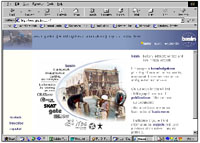|
Youth, ICT and
Development
Terri Willard twillard@iisd.ca "The new technologies that are changing our world are not a panacea or a magic bullet. But they are without doubt enormously powerful tools for development. They create jobs. They are transforming education, healthcare, commerce, politics and more. They can help in the delivery of humanitarian assistance and even contribute to peace and security." — Kofi Annan, United Nations Secretary-General, November 2001 In the global information society, young people are often the leading innovators in the use and spread of information and communication technologies (ICTs). Increasingly, youth are adapting and using these technologies (including, for example, telephone, fax, radio, television, film, computers and the Internet) to meet local information and communication needs. But young people can remain an untapped resource if decision-makers do not integrate their knowledge, vision and experience. Youth are leaders in ICT If at all there is an area where young people are leaders not just of tomorrow, but also of today, it is undoubtedly in the field of information and communication technologies. From Cameroon youth establishing net cafés, to Sri Lankan youth developing television programs, and the youth of Eastern Europe redefining political tactics through online activism - young people are at the forefront of transforming their societies through the information and communication revolution. Technology is what young people have (more than anyone else) grown up with, what they know more about than their parents and what gives them an edge. They are early adopters and adapters of technologies, ranging from mobile telephones to e-mail to instant messaging to radio and television. With the introduction of the Internet, these young people have acquired a powerful new tool to connect and to communicate. Today, young people go online more than anyone else, they stay online longer, and they have more diverse online activities. For many young people, the Internet is becoming a major source of education, news, and entertainment, as well as a new domain of communication, indeed community. On the Internet, a youth’s community is no longer a physical neighbourhood, but the entire world - and friends might well be on the other side of the globe. Young people are therefore coming face to face with personal experiences - challenges similar or different to their own - that provide an imperative for action. Youth are social entrepreneurs Young people are traditionally considered the most socially conscious and active segments of the population. They are concerned about environmental issues, the spread of HIV and other diseases, the lack of employment opportunities, economic inequality, and human rights. As students and young professionals, many seek to understand these issues and how their choices and actions impact others in their community and around the world. Given their lack of access to many formal institutions in society, young people have traditionally developed their own voluntary associations to address these challenges. Increasingly, young people are developing hybrid institutions blending the management and funding strengths of small-scale for-profit enterprises with non-profit goals and outreach abilities. By focusing on their goals, these social enterprises are flexible in their ability to create partnerships in support of social and environmental change. Many youth organizations have embraced ICTs as a possible source of income as they seek to educate and involve others in resolving critical social issues. They want to ensure that the introduction of these technologies in their communities does not further widen existing social and economic gaps. They are thus often at the forefront of linking ICTs to development goals. Untapped potential Many youth are already using technology for innovative social causes, often expanding access to information beyond those with personal access to technology. Yet, youth actions to bridge the digital divide often suffer from critical deficiencies:
Our challenge is to address these deficiencies, recognizing and capitalizing upon young people - a vital stakeholder in creating a more inclusive Information Society. We must find a way to make existing youth leaders in ICTS for development more effective and to rapidly involve more youth in such activities. The pool of potential talent and energy is vast. According to the UN Secretary General’s report on the Implementation of the World Program of Action for Youth to the Year 2000 and Beyond, young people aged 15-24 equal more than 18% of the world population. At least 85% of these young people live in developing nations where they make up 40% of the population within their countries. These young people are only beginning to gain access to many forms of ICTs and to experiment with their use in a wide variety of social and cultural contexts. If we take up the challenge of networking and engaging these young innovators, they will continue to act as development champions and focal points within their communities – leading to a more equitable, connected, and inclusive world. Progress to Date A variety of forums and processes have engaged, informed and mobilized youth in activities related to the information society:
These activities have provided the basis for extensive networks of young people and their supporters. What remains is to integrate these efforts to ensure that young people can learn from each other’s experiences and provide meaningful input to global processes. For that reason, the Global Knowledge Partnership, the International Institute for Sustainable Development, and TakingITGlobal have been working together to develop a framework strategy to nurture, promote and organize young people worldwide on matters of Information and Communications Technologies (ICTs) and Knowledge for Development. The resulting framework, Youth Creating Digital Opportunities, supports three activities - small tangible projects, an online ‘knowledge’ network, and youth participation within key decision-making forums. Within initial support from GKP members, these activities will be underway in time to facilitate youth participation in PrepCom 1 of the World Summit on the Information Society in July 2002. q For more information, visit http://ict.takingitglobal.org or contact: Terri Willard International Institute for Sustainable Development 161 Portage Avenue E., 6th floor Winnipeg, MB R3B 0Y4 Canada
|
||||||||||||||||||||||||||||
